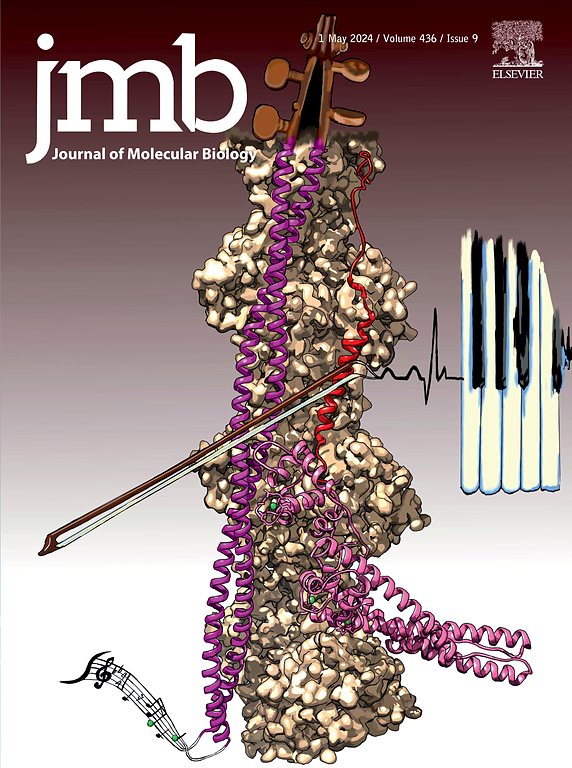揭示赤潮藻中受体介导的生物发光信号通路
IF 4.7
2区 生物学
Q1 BIOCHEMISTRY & MOLECULAR BIOLOGY
引用次数: 0
摘要
G蛋白偶联受体(gpcr)是多细胞生命中普遍存在的跨膜蛋白。人类的视觉、味觉和神经元活动都是由gpcr介导的,目前批准的药物中有很大一部分是针对gpcr的。然而,我们对GPCR在单细胞真核生物中的理解是不完整的,并且许多GPCR信号转导的成分在原生生物中被低估。先前研究生物发光鞭毛藻(一种参与珊瑚礁内共生和有毒赤潮的单细胞藻类)的工作暗示了生物发光信号通路中的gpcr,但尚未阐明构成该通路的单个成分。本文中,我们在鞭毛藻中发现了一种新的GPCR -生物发光诱导受体1 (BIR1),它在红潮华响应波浪湍流的生物发光信号通路中起着重要作用。此外,我们还发现了一个完整的内源性g蛋白复合物和下游效应物,它们是已知钙信号网络的组成部分。基于这些鉴定,我们使用敲低和敲除技术来证明BIR1在生物发光中的整体作用,并强调其在赤潮华中捕食者反应和剪切力诱导的GPCR信号转导中的作用。这一进展为红潮控制开辟了道路,并支持存在与水华毒性动力学相关的类似GPCR途径。本文章由计算机程序翻译,如有差异,请以英文原文为准。

Unraveling a Receptor-Mediated Bioluminescence Signaling Pathway in Red Tide Algae
G protein-coupled receptors (GPCRs) are ubiquitous transmembrane proteins in multicellular life. Human vision, taste, and neuron activity are all mediated by GPCRs, and a large percentage of currently approved drugs target GPCRs. However, our understanding of GPCRs in single-celled eukaryotes is incomplete, and many of the components of GPCR signal transduction are underrepresented in protists. Previous works studying bioluminescent dinoflagellates—single-celled algae involved in coral reef endosymbiosis and toxic red tide blooms—implicate GPCRs in a signaling pathway for bioluminescence but have not elucidated the individual components comprising the pathway. Herein, we identified a novel GPCR in dinoflagellates—Bioluminescence-Inducing Receptor 1 (BIR1)—which plays a significant role in the signaling pathway for bioluminescence in red tide blooms in response to wave turbulence. Additionally, we identified a full endogenous G-protein complex and downstream effectors that are integral to known calcium signaling networks. Based on these identifications, we used knockdown and knockout techniques to demonstrate the integral role of BIR1 in bioluminescence and highlight its role in predator response and shear force-elicited GPCR signaling in red tide blooms. This advance opens avenues for red tide control and supports the existence of similar GPCR pathways involved in bloom toxicity dynamics.
求助全文
通过发布文献求助,成功后即可免费获取论文全文。
去求助
来源期刊

Journal of Molecular Biology
生物-生化与分子生物学
CiteScore
11.30
自引率
1.80%
发文量
412
审稿时长
28 days
期刊介绍:
Journal of Molecular Biology (JMB) provides high quality, comprehensive and broad coverage in all areas of molecular biology. The journal publishes original scientific research papers that provide mechanistic and functional insights and report a significant advance to the field. The journal encourages the submission of multidisciplinary studies that use complementary experimental and computational approaches to address challenging biological questions.
Research areas include but are not limited to: Biomolecular interactions, signaling networks, systems biology; Cell cycle, cell growth, cell differentiation; Cell death, autophagy; Cell signaling and regulation; Chemical biology; Computational biology, in combination with experimental studies; DNA replication, repair, and recombination; Development, regenerative biology, mechanistic and functional studies of stem cells; Epigenetics, chromatin structure and function; Gene expression; Membrane processes, cell surface proteins and cell-cell interactions; Methodological advances, both experimental and theoretical, including databases; Microbiology, virology, and interactions with the host or environment; Microbiota mechanistic and functional studies; Nuclear organization; Post-translational modifications, proteomics; Processing and function of biologically important macromolecules and complexes; Molecular basis of disease; RNA processing, structure and functions of non-coding RNAs, transcription; Sorting, spatiotemporal organization, trafficking; Structural biology; Synthetic biology; Translation, protein folding, chaperones, protein degradation and quality control.
 求助内容:
求助内容: 应助结果提醒方式:
应助结果提醒方式:


